1997 CHEVROLET CAVALIER service interval
[x] Cancel search: service intervalPage 284 of 388
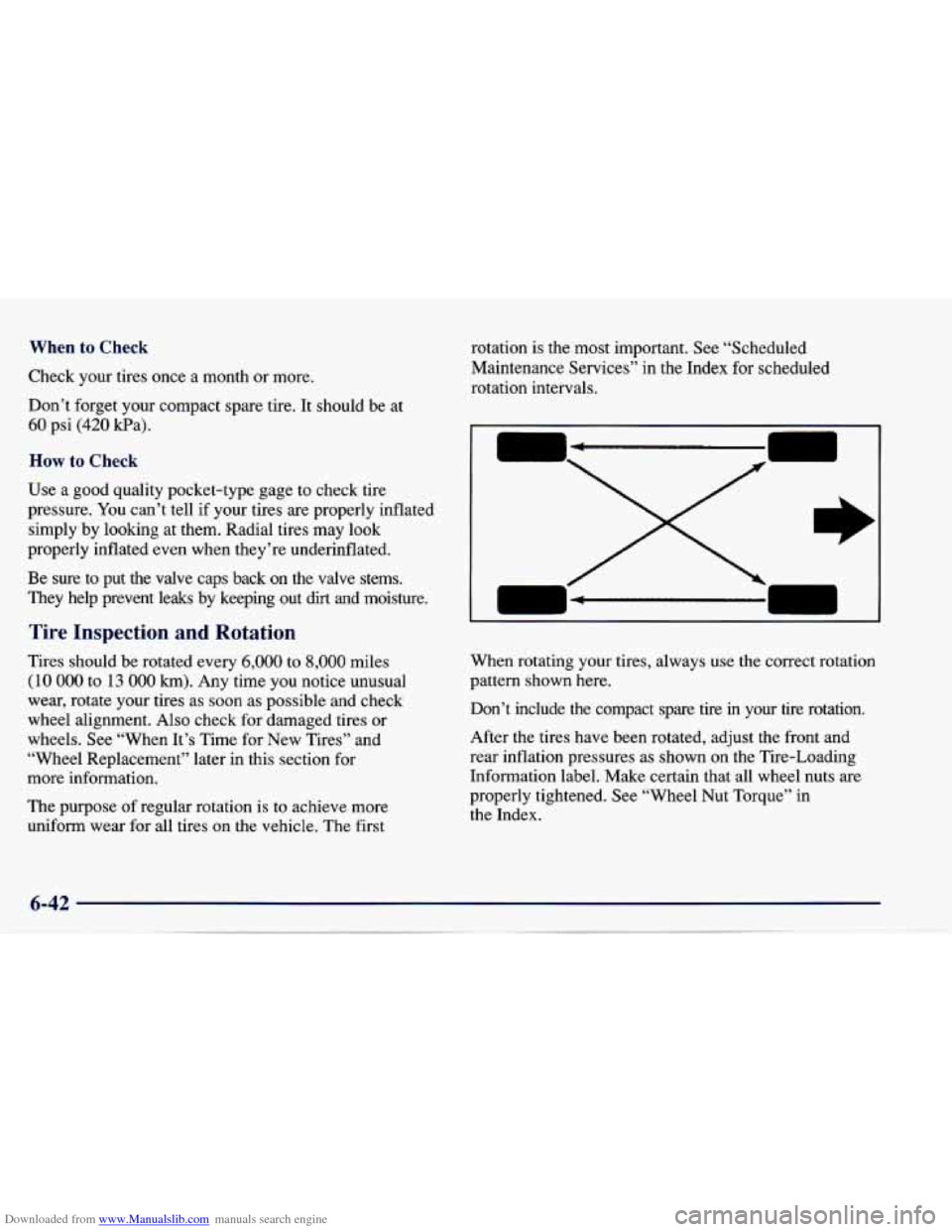
Downloaded from www.Manualslib.com manuals search engine When to Check
Check your tires once a month or more.
Don’t forget your compact spare tire. It should be at
60 psi (420 Pa).
How to Check
Use a good quality pocket-type gage to check tire
pressure.
You can’t tell if your tires are properly inflated
simply by looking at them. Radial tires may look
properly inflated even when they’re underinflated.
Be sure to put the valve caps back on the valve stems.
They help prevent leaks by keeping out dirt
and moisture.
Tire Inspection and Rotation
Tires should be rotated every 6,000 to 8,000 miles
(10
000 to 13 000 km). Any time you notice unusual
wear, rotate your tires as soon as possible and check
wheel alignment. Also check for damaged tires or
wheels. See “When It’s Time for New Tires” and
“Wheel Replacement” later in this section for
more information.
The purpose of regular rotation is to achieve more
uniform wear for all tires on the vehicle. The first rotation is the most important.
See “Scheduled
Maintenance Services’’ in the Index for scheduled
rotation intervals.
n
*
I1
When rotating your tires, always use the correct rotation
pattern shown here.
Don’t include the compact spare tire in your tire rotation. \
After the tires have been rotated, adjust the front and
rear inflation pressures
as shown on the Tire-Loading
Information label. Make certain that all wheel nuts are
properly tightened. See “Wheel
Nut Torque” in
the Index.
Page 313 of 388
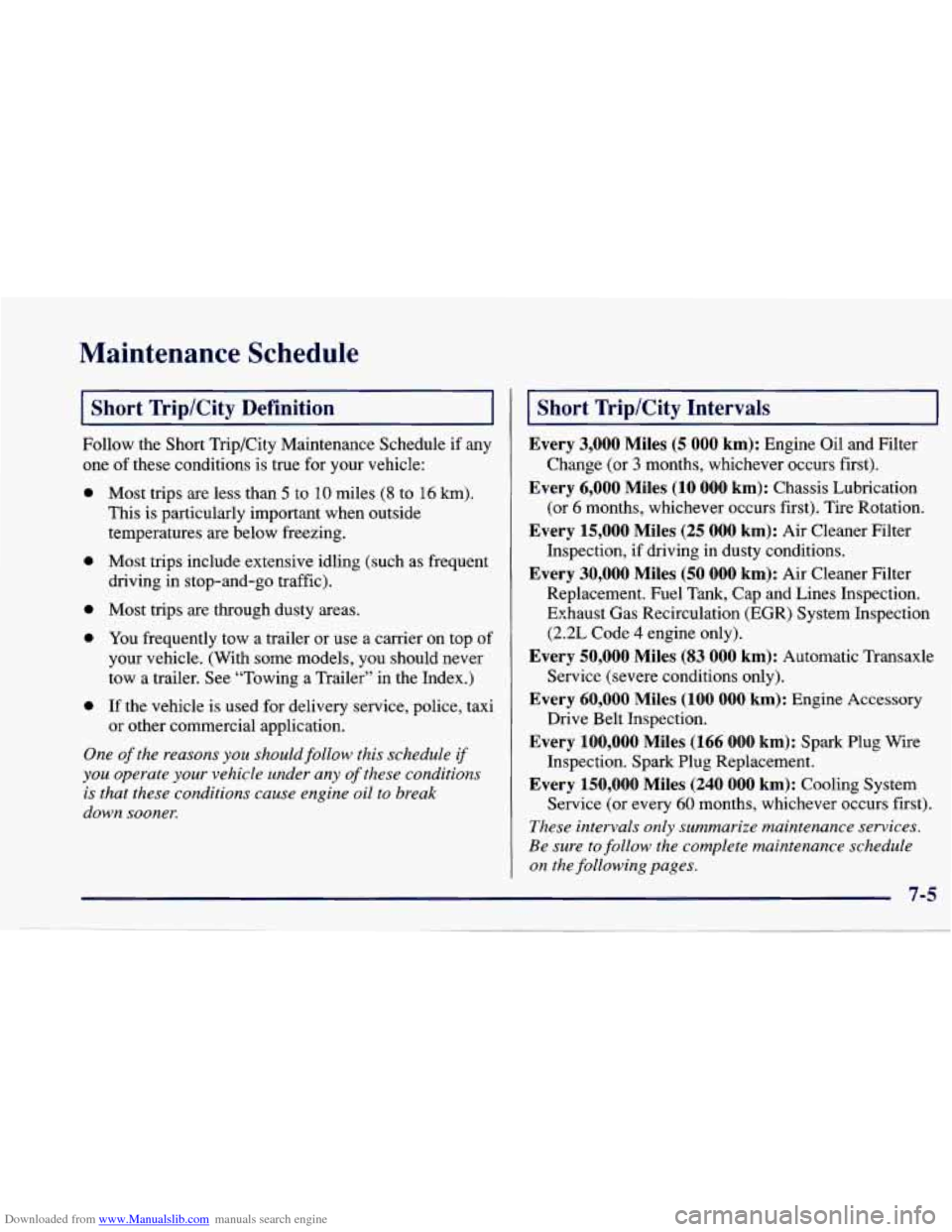
Downloaded from www.Manualslib.com manuals search engine Maintenance Schedule
(Short Trip/City Definition
Follow the Short Trip/City Maintenance Schedule if any
one of these conditions is true for your vehicle:
0
e
0
0
e
Most trips are less than 5 to 10 miles (8 to 16 km).
This is particularly important when outside
temperatures are below freezing.
Most trips include extensive idling (such as frequent
driving in stop-and-go traffic).
Most trips are through dusty areas.
You frequently tow a trailer or use a carrier on top of
your vehicle. (With some models,
you should never
tow a trailer. See “Towing
a Trailer’’ in the Index.)
If the vehicle is used for delivery service, police, taxi
or other commercial application.
One of the reasons you should follow this schedule if
you operate your vehicle under any of these conditions
is that these conditions cause engine oil to break
down sooney.
Short Trip/City Intervals
Every 3,000 Miles (5 000 km): Engine Oil and Filter
Every 6,000 Miles (10 000 km): Chassis Lubrication
Every 15,000 Miles (25 000 km): Air Cleaner Filter
Every 30,000 Miles (50 000 km): Air Cleaner Filter
Change
(or
3 months, whichever occurs first).
(or
6 months, whichever occurs first). Tire Rotation.
Inspection, if driving in dusty conditions.
Replacement. Fuel Tank, Cap and Lines Inspection.
Exhaust Gas Recirculation (EGR) System Inspection
(2.2L Code
4 engine only).
Every 50,000 Miles (83 000 km): Automatic Transaxle
Service (severe conditions only).
Every 60,000 Miles (100 000 km): Engine Accessory
Drive Belt Inspection.
Every 100,000 Miles (166 000 km): Spark Plug Wire
Inspection. Spark Plug Replacement.
Every 150,000 Miles (240 000 km): Cooling System
Service (or every
60 months, whichever occurs first).
These intervals only summarize maintenance services.
Be
sure to follow the complete maintenance schedule
on the following pages.
Page 314 of 388
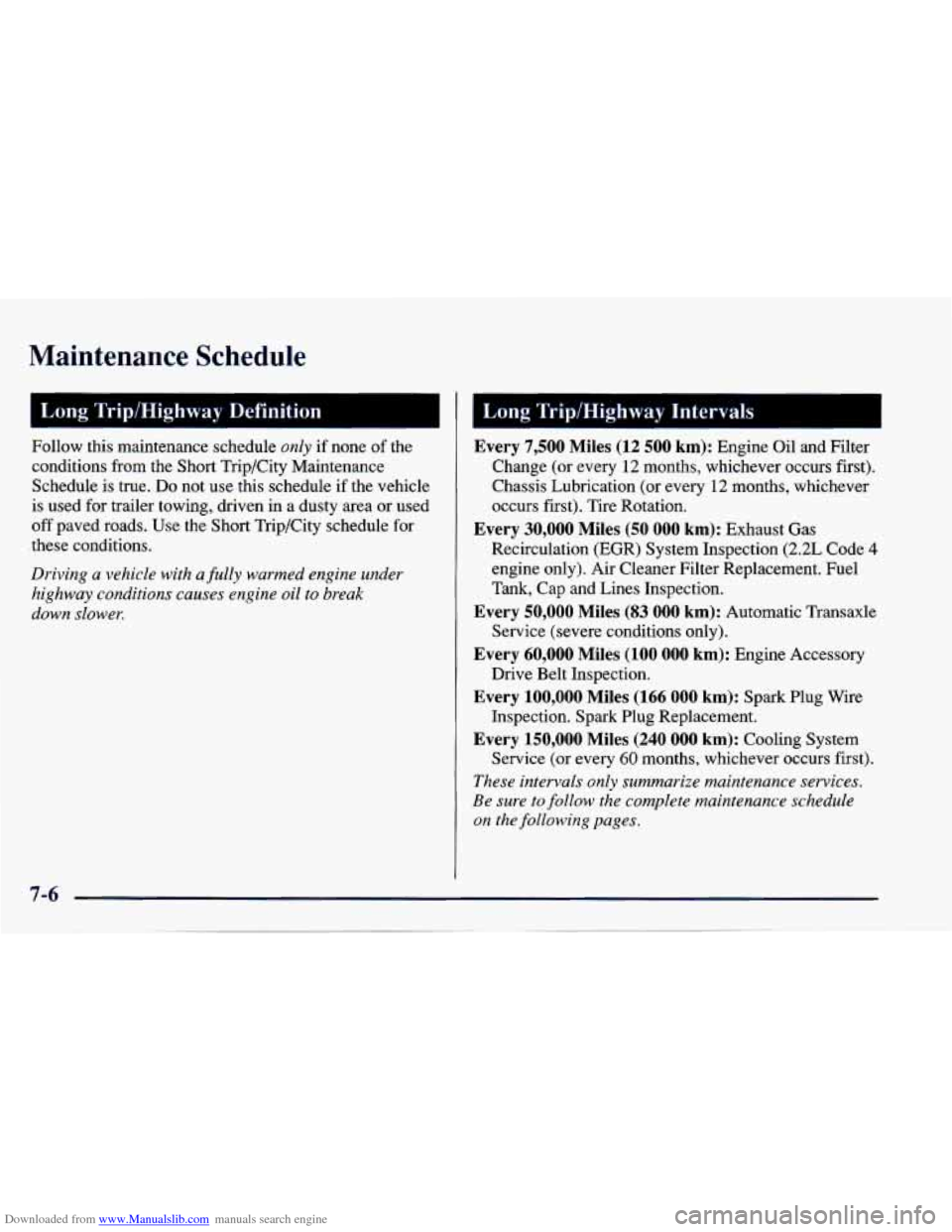
Downloaded from www.Manualslib.com manuals search engine Maintenance Schedule
I Long Trip/Highway Definition
Follow this maintenance schedule only if none of the
conditions from the Short Trip/City Maintenance
Schedule is true.
Do not use this schedule if the vehicle
is used for trailer towing, driven in a dusty area or used
off paved roads. Use the Short Trip/City schedule for
.these conditions.
Driving a vehicle with a fully warmed engine under
highway conditions causes engine oil to break
down slower.
I 1 Long Trip/Highway Intervals
Every 7,500 Miles (12 500 km): Engine Oil and Filter
Change (or every
12 months, whichever occurs first).
Chassis Lubrication (or every 12 months, whichever
occurs first).
Tire Rotation.
Recirculation (EGR) System Inspection (2.2L Code
4
engine only). Air Cleaner Filter Replacement. Fuel
Tank, Cap and Lines Inspection.
Every 50,000 Miles (83 000 km): Automatic Transaxle
Service (severe conditions only).
Every 60,000 Miles (100 000 km): Engine Accessory
Drive Belt Inspection.
Every 100,000 Miles (166 000 km): Spark Plug Wire
Inspection. Spark Plug Replacement.
Every 150,000 Miles (240 000 km): Cooling System
Service (or every
60 months, whichever occurs first).
These intervals only summarize maintenance services.
Be sure
to follow the complete maintenance schedule
on the following pages.
Every 30,000 Miles (50 000 km): Exhaust Gas
Page 315 of 388
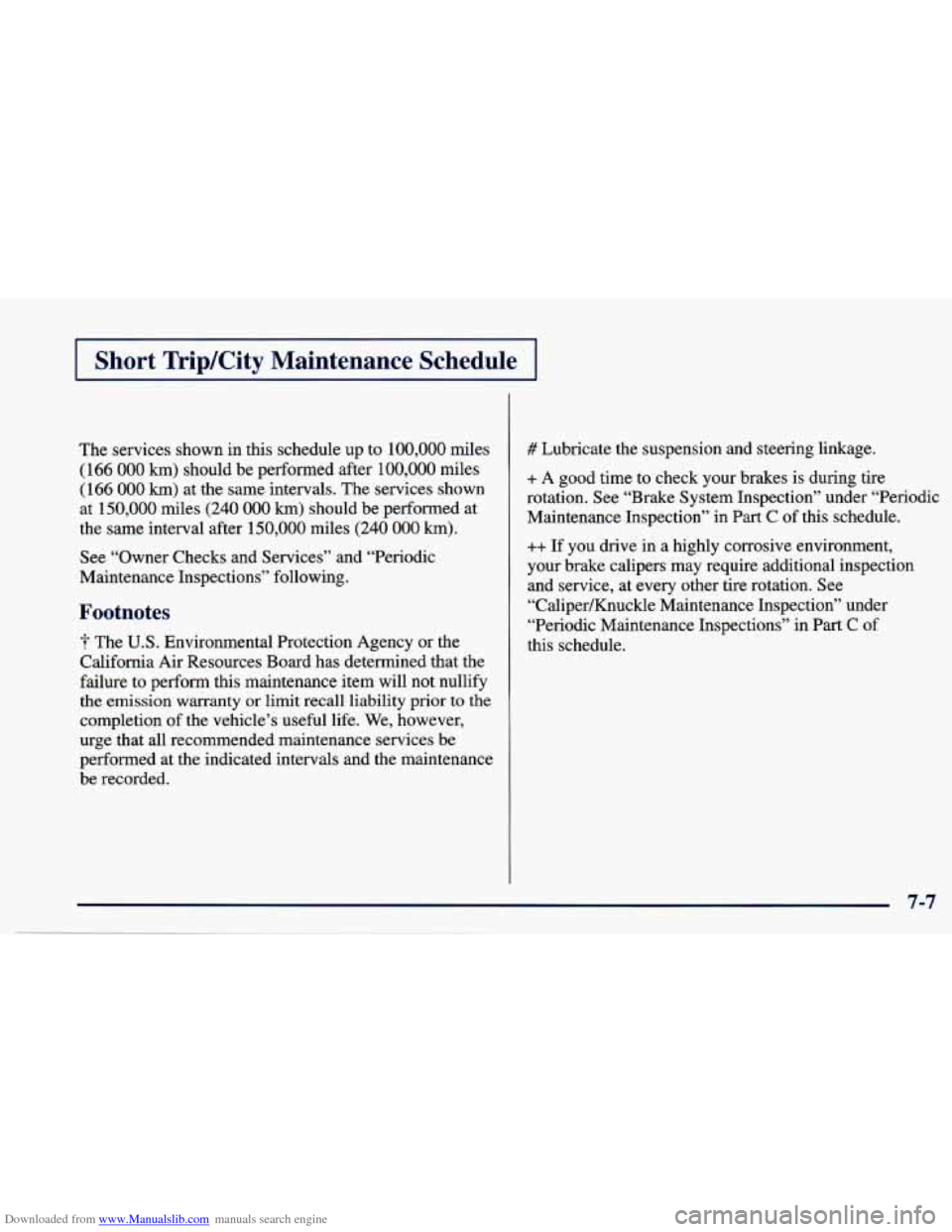
Downloaded from www.Manualslib.com manuals search engine Short Trip/City Maintenance Schedule I
The services shown in this schedule up to 100,000 miles
( 166 000 km) should be performed after 100,000 miles
(166
000 km) at the same intervals. The services shown
at 150,000 miles
(240 000 km) should be performed at
the same interval after 150,000 miles
(240 000 km).
See “Owner Checks and Services” and “Periodic
Maintenance Inspections” following.
Footnotes
The U.S. Environmental Protection Agency or the
California Air Resources Board has determined that the
failure to perform this maintenance item will not nullify
the emission warranty or limit recall
liability prior to the
completion of the vehicle’s useful life. We, however,
urge that all recommended maintenance services be
performed at the indicated intervals and the maintenance
be recorded.
# Lubricate the suspension and steering linkage.
+ A good time to check your brakes is during tire
rotation. See “Brake System Inspection” under “Periodic
Maintenance Inspection” in
Part C of this schedule.
++ If you drive in a highly corrosive environment,
your brake calipers may require additional inspection
and service, at every other tire rotation. See
“Caliper/Knuckle Maintenance Inspection’’ under
“Periodic Maintenance Inspections’’ in Part
C of
this schedule.
7-7
-- . . . .
Page 337 of 388
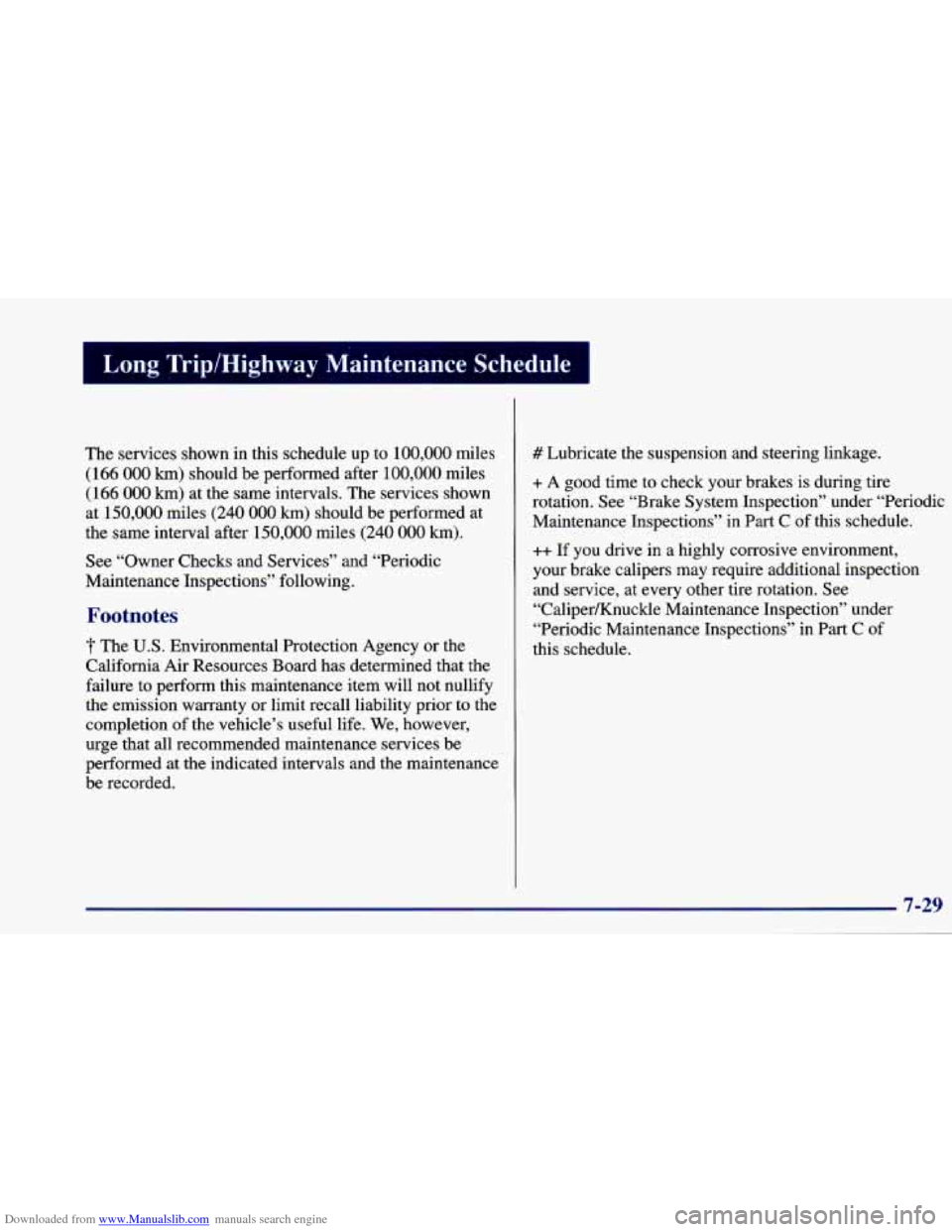
Downloaded from www.Manualslib.com manuals search engine I Long Trip/Highway Maintenance Schedule I
The services shown in this schedule up to 100,000 miles
(166
000 km) should be performed after 100,000 miles
(166
000 km) at the same intervals. The services shown
at 150,000 miles
(240 000 km) should be performed at
the same interval after 150,000 miles
(240 000 km).
See “Owner Checks and Services” and “Periodic
Maintenance Inspections” following.
Footnotes
f The U.S. Environmental Protection Agency or the
California Air Resources Board has determined that the
failure to perform this maintenance item will not nullify
the emission warranty or limit recall liability prior to the
completion of the vehicle’s useful life. We, however,
urge that all recommended maintenance services be
performed at the indicated intervals and the maintenance
be recorded.
# Lubricate the suspension and steering linkage.
+ A good time to check your brakes is during tire
rotation. See “Brake System Inspection” under “Periodic
Maintenance Inspections” in Part
C of this schedule.
++ If you drive in a highly corrosive environment,
your brake calipers may require additional inspection
and service, at every other tire rotation. See
“CalipedKnuckle Maintenance Inspection” under
“Periodic Maintenance Insnections”
in Part C of
this schedule.
7-29
Page 349 of 388
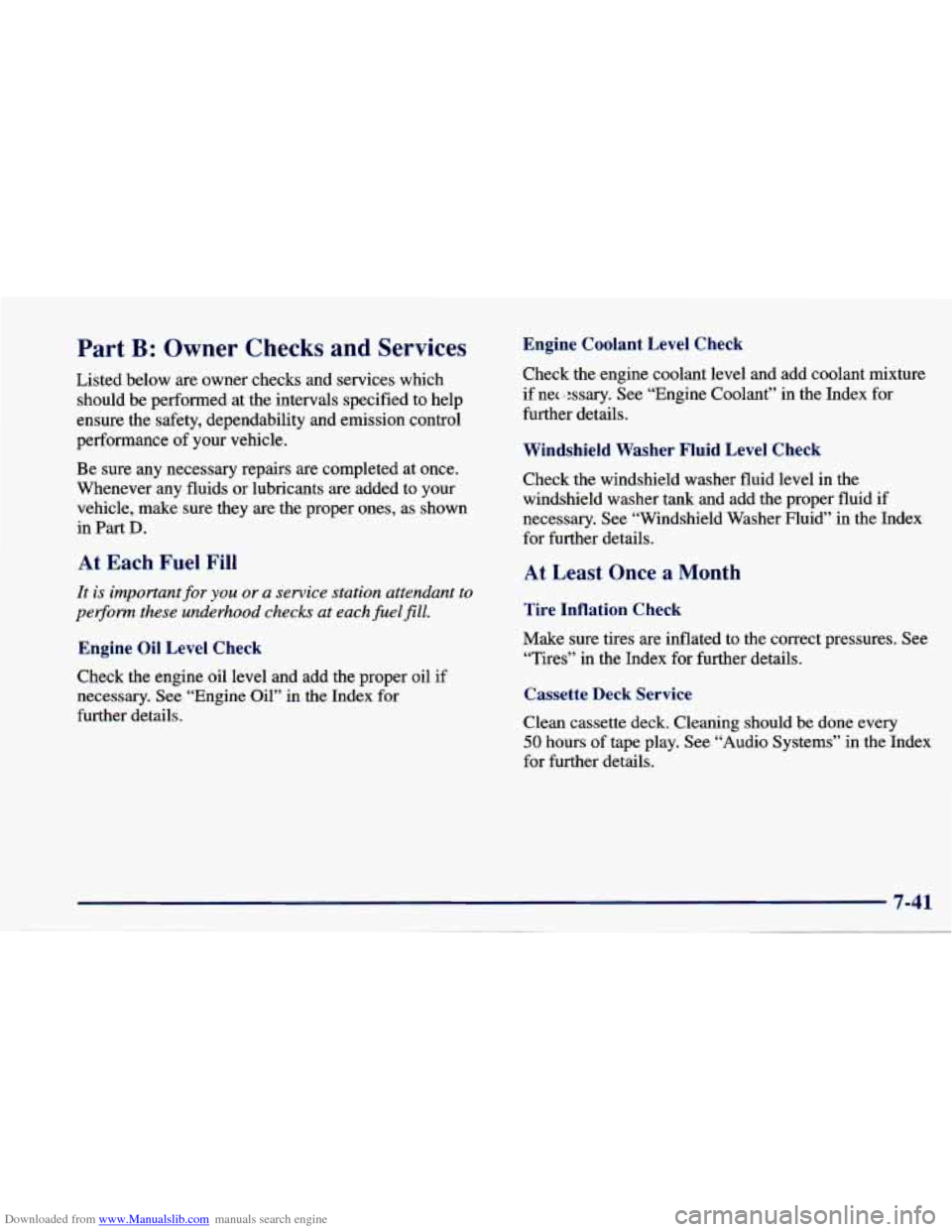
Downloaded from www.Manualslib.com manuals search engine Part B: Owner Checks and Services
Listed below are owner checks and services which
should be performed at the intervals specified to help
ensure the safety, dependability and emission control
performance of your vehicle.
Be sure any necessary repairs are completed at once.
Whenever any fluids or lubricants are added to your
vehicle, make sure they are the proper ones, as shown
in Part D.
At :ach Fuel Fill
It is important for you or a service station attendant to
per3cor-m these underhood checks at each
fuel fill.
Engine Oil Level Check
Check the engine oil level and add the proper oil if
necessary. See “Engine Oil”
in the Index for
further details.
Engine Coolant Level Check
Check the engine coolant level and add coolant mixture
if nec
.I :ssary. See “Engine Coolant” in the Index for
further details.
Windshield Washer Fluid Level Check
Check the windshield washer fluid level in the
windshield washer tank and add the proper fluid if
necessary. See “Windshield Washer Fluid”
in the Index
for further details.
At Least Once a Month
Tire Inflation Check
Make sure tires are inflated to the correct pressures. See
“Tires” in the Index for further details.
Cassette Deck Service
Clean cassette deck. Cleaning should be done every
50 hours of tape play. See “Audio Systems” in the Index
for further details.
Page 358 of 388
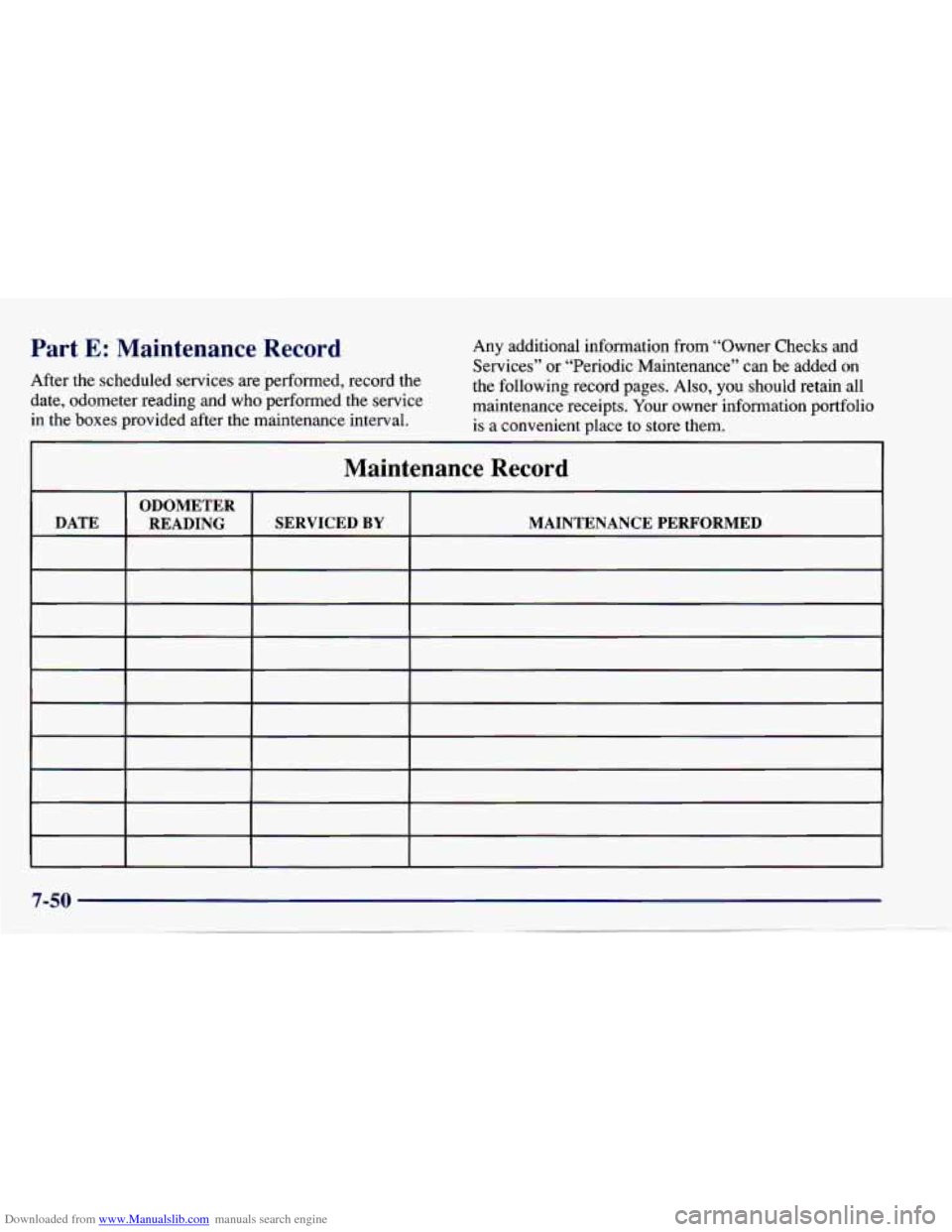
Downloaded from www.Manualslib.com manuals search engine Part E: Maintenance Record
After the scheduled services are performed, record the
date, odometer reading and who performed the service
in the boxes provided after the maintenance interval. Any additional information
from “Owner Checks and
Services” or “Periodic Maintenance” can be added
on
the following record pages. Also, you should retain all
maintenance receipts. Your owner information portfolio
is a convenient place to store them.
Maintenance Record
ODOMETER
DATE READING SERVICED
BY MAINTENANCE PERFORMED
Maintenance Record
Page 380 of 388
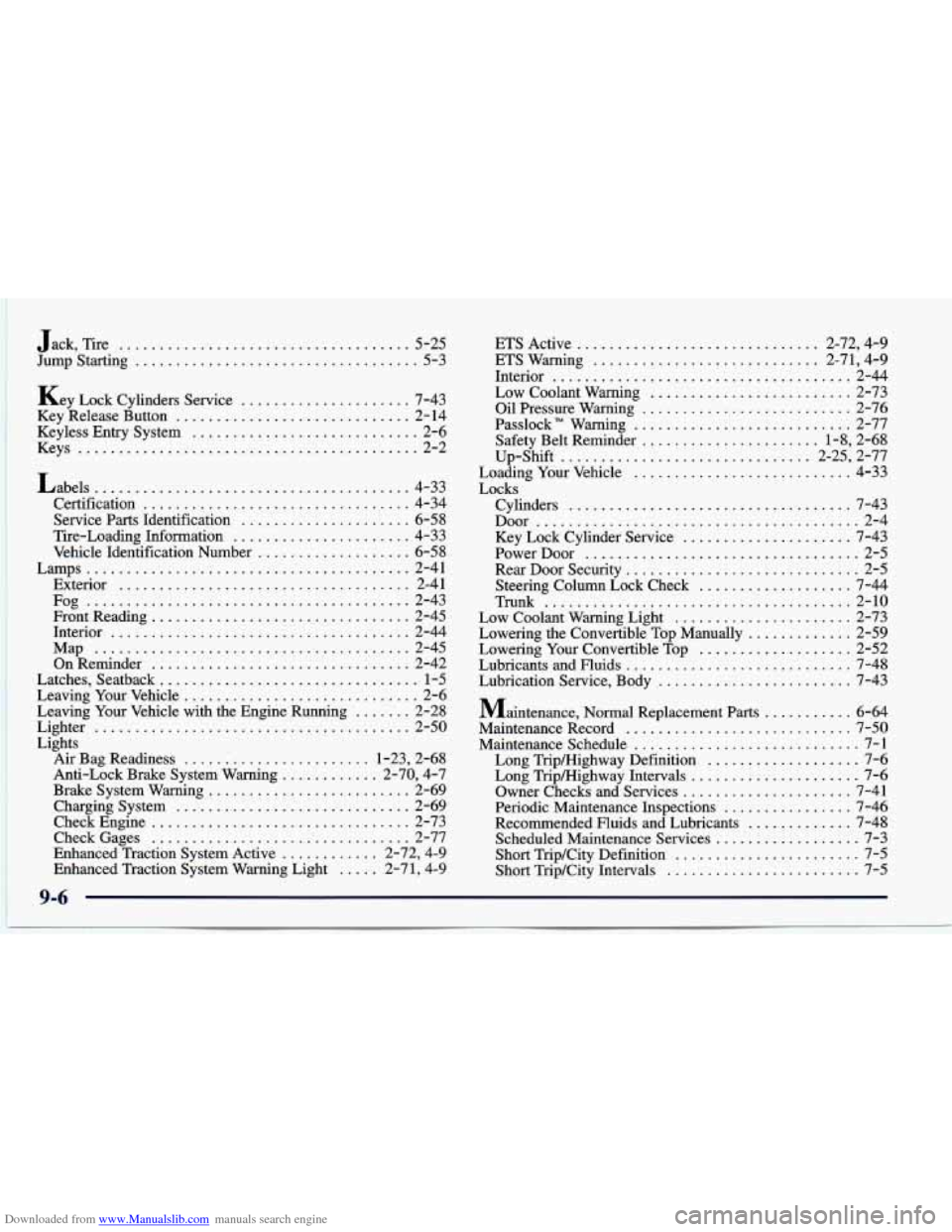
Downloaded from www.Manualslib.com manuals search engine Jack. Tire .................................... 5-25
Jump Starting
................................... 5-3
Key Lock Cylinders Service
..................... 7-43
Key Release Button
............................. 2-14
Keyless Entry System
............................ 2-6
Keys
.......................................... 2-2
Labels
....................................... 4-33
Certification
................................. 4-34
Service Parts Identification
..................... 6-58
Tire-Loading Information ...................... 4-33
Vehicle Identification Number
................... 6-58
Lamps
........................................ 2-41
Exterior
.................................... 2-41
Fog
........................................ 2-43
FrontReading
................................ 2-45
Interior
..................................... 2-44
Map
....................................... 2-45
OnReminder
................................ 2-42
Latches. Seatback
................................ 1-5
Leaving Your Vehicle
............................. 2-6
Leaving Your Vehicle with the Engine Running
....... 2-28
Lighter
....................................... 2-50
Lights Air Bag Readiness
..... i ................. 1-23. 2-68
Anti-Lock Brake System Warning
............ 2.70. 4.7
Brake System Warning
......................... 2-69
Charging System
............................. 2-69
CheckEngine
................................ 2-73
Enhanced Traction System Active
............ 2.72. 4.9
Enhanced Traction System Warning Light
..... 2.71. 4.9
CheckGages
................................ 2-77
ETS Active .............................. 2.72. 4.9
ETS Warning
............................ 2.71. 4.9
Interior
..................................... 2-44
Low Coolant Warning
......................... 2-73
Oil Pressure Warning
.......................... 2-76
Passlock
TM Warning ........................... 2-77
Safety Belt Reminder
...................... 1.8. 2.68
Loading Your Vehicle
........................... 4-33
Locks Cylinders
................................... 7-43
Door
........................................ 2-4
Key Lock Cylinder Service
..................... 7-43
Power Door
.................................. 2-5
Rear Door Security ............................. 2-5
Steering Column Lock Check
................... 7-44
Trunk
...................................... 2-10
Low Coolant Warning Light
...................... 2-73
Lowering the Convertible Top Manually
............. 2-59
Lowering Your Convertible Top
................... 2-52
Lubricants and Fluids
............................ 7-48
Lubrication Service. Body
........................ 7-43
Maintenance.
NO~Z~I Replacement parts ........... 6-64
Maintenance Record
............................ 7-50
Maintenance Schedule
............................ 7-1
Long Trip/Highway Definition
................... 7-6
Long TripMighway Intervals
..................... 7-6
Owner Checks and Services
..................... 7-41
Periodic Maintenance Inspections
................ 7-46
Recommended Fluids and Lubricants
............. 7-48
Scheduled Maintenance Services
.................. 7-3
Short TripKity Definition
....................... 7-5
Short TripKity Intervals
........................ 7-5
Up-Shift
............................... 2.25. 2.77